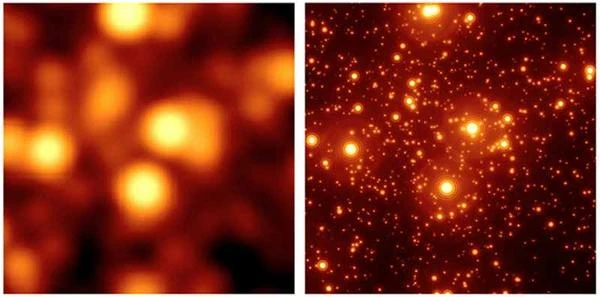
The Earth's atmosphere is dynamic, with air layers that are heterogeneous in temperature. These layers move, mix, exchange energy, and the disturbances caused by pressure, heat, humidity, and movement greatly hinder astronomical observations made from the ground. Moreover, this atmospheric turbulence is permanent and unpredictable.
The images received by telescopes tremble to the rhythm of the agitations and eddies of air molecules. We say that the wavefront is disturbed. The flat wavefront, which has traveled for billions of years, breaks in the last milliseconds of its journey, in the Earth's atmosphere. Since 2010, the AO system has been part of the standard equipment of major observatories.
Adaptive Optics (AO) is a technique that corrects in real time the distortions caused by atmospheric turbulence. These disturbances alter the light wavefront and degrade the resolution of ground-based telescopes. The system is based on a deformable mirror controlled by a wavefront analyzer, which was proposed in 1953 by the American astronomer, Horace Babcock (1912-2003).
When observing an area of the sky where there is no bright star to guide a telescope, astronomers create their own luminous reference: an artificial laser guide star. They send a yellow laser beam to a thin layer of sodium located about 90 km above the mesosphere. The sodium atoms are excited and send back visible light from the ground: a bright point is obtained, which serves as a reference to correct the effects of atmospheric turbulence and obtain much sharper images.
N.B.:
There is indeed a layer of sodium in the Earth's mesosphere, centered around 90 km altitude. It is not a visible "cloud," but an extremely thin veil of Na atoms resulting from the ablation of micrometeoroids.
A sensor observes how the light from a star or a laser guide star is distorted as it passes through the atmosphere. A computer translates these distortions into a map that indicates where and how much the mirror must be bent to compensate. Tiny actuators push or pull on the back of the mirror by a few tens of nanometers, to restore a regular propagation surface to the light. This measure-analyze-correct cycle is repeated hundreds to thousands of times per second, to follow the variations of turbulence in real time.
The goal is to almost completely cancel out the deformations imposed by the air, to obtain images as sharp as if the telescope were in space. The quality is measured by the Strehl ratio, which increases as adaptive optics reduces the residual error.
In practice, the combination of a precise sensor, a robust reconstruction algorithm, and a fast, dense DM allows obtaining corrected images that approach the diffraction limit of the telescope for the corrected spectral band and angle.
AO systems equipping telescopes such as the VLT or Keck allow obtaining images whose resolution approaches the diffraction limit. They are essential for imaging exoplanets, studying galactic nuclei, or compact star clusters.
| Instrument | Telescope | Corrected altitude | Comment |
|---|---|---|---|
| SPHERE | VLT (ESO) | > 90% of turbulence | Optimized for direct imaging of exoplanets and high contrast |
| Keck AO | Keck II | > 80% | First operational laser AO system on a large ground-based telescope |
| GPI | Gemini South | > 85% | Designed to observe young giant planets close to their star |
| MagAO-X | Magellan Clay (LCO) | > 85% | High contrast visible and infrared for planetary and stellar imaging |
| SCExAO | Subaru | > 80% | Focused on high-resolution imaging and coronagraph for exoplanets |
| ERIS | VLT (ESO) | > 90% | Replaces NACO for near-infrared, improving contrast and resolution |
| NFIRAOS | TMT (under construction) | Planned > 90% | First multi-conjugate AO planned for the future Thirty Meter Telescope |
Sources: ESO, Keck Observatory, Gemini Observatory, MagAO-X, Subaru Telescope, TMT Project.